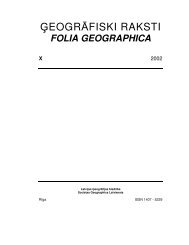eogrÄfiski raksti folia geographica xii - Ä¢eogrÄfijas un Zemes zinÄtņu ...
eogrÄfiski raksti folia geographica xii - Ä¢eogrÄfijas un Zemes zinÄtņu ...
eogrÄfiski raksti folia geographica xii - Ä¢eogrÄfijas un Zemes zinÄtņu ...
Create successful ePaper yourself
Turn your PDF publications into a flip-book with our unique Google optimized e-Paper software.
41<br />
NATURE RESEARCH<br />
land and loss of moisture, for instance mP→ xPs→ cSp or mA→ xP [Geb 1981]. Continental air<br />
is also transformed <strong>un</strong>der growing solar radiation (cP→cPs).<br />
In ES the weather of Latvia is greatly influenced by anticyclonal atmospheric circulation.<br />
An area of high pressure may be located either over the European part of Russia, a ridge of high<br />
pressure may spread from the Azores High, but often a ridge of high pressure develops over<br />
Scandinavia behind a cold front. The latter passes quickly onwards and decays. Depending on<br />
the position taken up by the area of high pressure, transformed maritime air (xP, xPs or xSp ) or<br />
the corresponding subtype of continental air is identified.<br />
Reviewing of every-day air mass occurrence from vernal equinox to mid-April<br />
<strong>un</strong>ambiguously showed that on average it was still the P+A pattern. The mP air together with xP<br />
air, its first modification, arrived on 36% and cold winter air masses (xA, mA, cP) prevailed on<br />
34% of days. However, a small increase of xPs air was observed, its frequency increasing to<br />
10% (fronts excluded). On the whole, warm (Ps, Sp) air masses arrived on average as often as in<br />
other P+A seasons (30%). Occasionally, ES may bring very warm weather, as was observed in<br />
1991, when mid-day temperature reached 18-20ºC. However, on average the expansion of the<br />
mid-latitude air source region from central and southern parts of Europe to the northeast is<br />
apparently gradual, and early spring gives no hint about it. Latvia starts receiving mid-latitude<br />
air masses from southern and central Europe, and from the southern part of Russia more often<br />
starting with the second half of April.<br />
On average, the high frequency of continental (mainly cP) air and transformed maritime<br />
air masses result in very low amo<strong>un</strong>ts of precipitation (Table 1).<br />
Full spring, FSP (middle of April to the first half of May)<br />
During this season, the majority of migratory birds have returned, almost the entire<br />
vegetation quite evidently comes back to life and the land becomes green. The birch trees are<br />
the first to <strong>un</strong>fold their leaves, with the earliest observed cases in the second decade of April.<br />
Another early species is black-currant, which commonly stays 1-2 weeks behind the birch. The<br />
s<strong>un</strong>shine duration is already aro<strong>un</strong>d 8 hours, reaching 50% of the possible during this season,<br />
and its increase slows down (Table 2). However, Rnt and T are still growing noticeably. On<br />
average, from April to May Rnt increased by 165%, and Td from +5° to +10°C.<br />
Full spring may be named a season with no dominant air mass. The frequency of midlatitude<br />
(Sp) and warmed subpolar (Ps) air increases considerably while the influence of subpolar<br />
air (primarily continental type cP) decreases, so that the warm and temperate air masses become<br />
almost as frequent as the cold ones are. The coldest air mass of the season, i.e. xA air, was<br />
identified 4 years in the 11-year period, when cold spells occurred for 1-2 days. Maritime arctic<br />
air mA was identified each year with the same duration as xA air. In full spring and presummer,<br />
the frequency of mP air is the lowest within the year, and it is regarded as a temperate<br />
air mass for this season. Air temperatures at mid-day may rise to +10º to +14ºC, dropping at<br />
night to aro<strong>un</strong>d +5ºC. The cloud cover, including low clouds, brings about a small diurnal<br />
temperature range. The warm air masses (even subtropical air) arrive more often (Figure 6 ).<br />
It is noteworthy that transformed maritime air mass types become dominant (<strong>un</strong>til late<br />
summer) and the frequency of oceanic air masses decreases while the rate of continental air<br />
masses does not change significantly. The transformed maritime air masses (xP, xPs and xSp)<br />
occur more often. The low degree of cloudiness and the presence of relatively cold (mA, cP) air<br />
result in low night-time temperatures and frost, but in mid-day the temperature often rises to<br />
+15° to + 20°C. The spells of cold air, although short-term and less frequent than in previous<br />
seasons, are more noticeable because they occur during the growing season and stand out<br />
against the backgro<strong>un</strong>d of higher frequency warm mid-latitude and subtropical air. Both the<br />
diurnal range and the daily means of air temperature are highly variable.<br />
As regards moisture regime, precipitation remains low and does not exceed<br />
evapotranspiration, while solar radiation and air temperature grows rapidly and the growing<br />
activity of vegetation also increases. Therefore the ab<strong>un</strong>dance of water on the soil surface and in<br />
soil, which is characteristic of ES landscape, disappears quite soon.

















